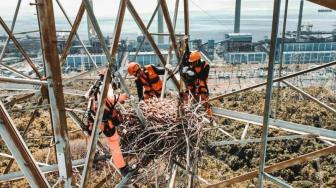
Indonesia Sets Ambitious Plan for Renewable Energy in 10 Years
Three ministers held a coordination meeting to discuss the 2025-2034 Electricity Supply Business Plan (RUPTL).

Three ministers held a coordination meeting to discuss the 2025-2034 Electricity Supply Business Plan (RUPTL).

The nest posed a danger to electric power transmission.

PTT's board of directors approved the sale of PTT International Holdings Limited, a wholly-owned subsidiary of PTT, of its entire investment, to 100 percent of the total issued shares, in PTTML to Astrindo.

TheIndonesia.id - Director of the Bioenergy and Surfactant Research Center IPB University Meika Syahbana Rusli said that Java Island has the potential for 916 thousand hectares of dry land to produce biomass in an area of 60 kilometers from the steam power plant (PLTU).
"In general, the biomass potential can come from agriculture and plantations," said Rusli in a statement quoted by Antara in Jakarta, Friday, July 1, 2022.
If State Electricity Company (PLN) implements a 5.0 percent co-firing policy on 16 PLTUs, it will only require 189 thousand hectares. If the percentage is increased to 10 percent or around 379 thousand hectares, it means that the land is still sufficient for the development of biomass.
Co-firing technology is a way to reduce carbon emissions in steam power plants or coal power plants. The wide expanse of dry land has become the main resource for growing crops as the main raw material for biomass in energy substitution.
Rusli took an example for the development of biomass from Riau alone, which could reach 20 million tons using palm oil waste. North Sumatra is said to have a lot of biomass potential too.
"But in Java, there is no less, from the farming sector, there are straw, husks, and so on. All of them have the potential to be used as energy sources," he said.
Regarding land availability, Rusli assessed that community involvement needs to be done so that PLN and the government are not alone in facing energy challenges. Based on data from the Ministry of Environment and Forestry; the categories of community plantation forest, community forest, and village forest alone has enough potential.
Without taking into account other forest management categories such as natural forest, utilization permits for social forestry, and forestry partnerships, there are 572 thousand hectares that can be used by the community. Rusli gave notes on how to move people to want to cultivate energy plants such as calliandra, gamal, lamtoro, sengon, and others.
In addition to thinking about intercropping between energy crops and other crops, the economics of supply is also important. Furthermore, creating an energy plant ecosystem that involves the community through farmer groups, processing parties which can be from a subsidiary of PLN or the private sector, until finally accepted by the PLTU.
"This is PLN's concern so that the supply of biomass continues from time to time," Rusli said.
So far, IPB has conducted a feasibility and economic analysis of the potential of timber which is considered competitive when planted and sold by farmers. Even though Japan and South Korea do not have adequate biomass sources, they have policies supporting the program.
"North America, Brazil, and Australia did not do it because of inadequate government support. So the record can run if there is policy support and incentives," he said.
PT PLN (Persero) continues to demonstrate its commitment to increasing the share of clean energy and towards carbon neutrality by 2060. After implementing the co-firing step by combining the portion of biomass in its PLTU, PLN now involves community participation in this energy transition agenda.
PLN President Director Darmawan Prasodjo said there is a potential for the future to be bleak because of global warming if there is no joint effort to prevent it. He explained that every kilowatt-hour of electricity produced contains carbon emissions that need to be controlled.
PLN has PLTU assets that rely a lot on coal, so the idea of reducing emissions through co-firing emerged in addition to the option of early retirement for these assets. Coal production is said to produce one kilogram of carbon emissions for every kilowatt hour produced.
"We are here to determine our future. Future generations must have a better future. The way is collaboration to reduce carbon emissions," said Darmawan.
Currently, PLN is increasing the use of this co-firing throughout Indonesia. In addition to reducing carbon emissions released from PLTU, community involvement in biomass development can be a new point of economic growth.